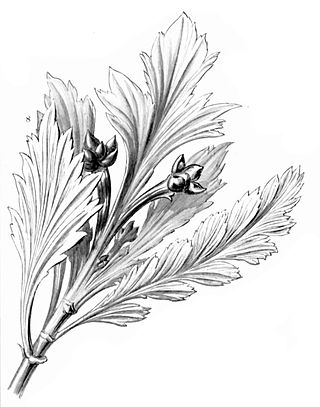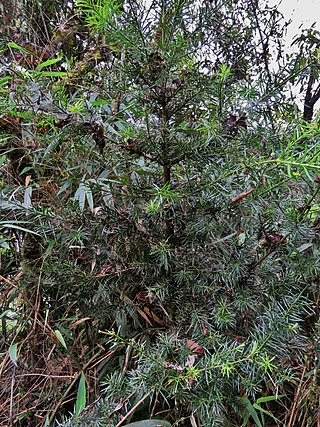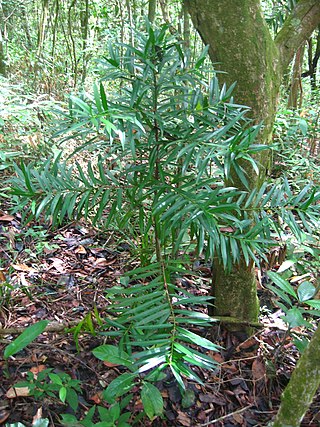
Podocarpus totara (; the tōtara is a species of podocarp tree endemic to New Zealand. It grows throughout the North Island, South Island and rarely on Stewart Island / Rakiura in lowland, montane and lower subalpine forest at elevations of up to 600 m.

Prumnopitys taxifolia, the mataī or black pine, is an endemic New Zealand coniferous tree that grows on the North Island and South Island. It also occurs on Stewart Island/Rakiura but is uncommon there.

Pinus serotina, the pond pine, black bark pine, bay pine,marsh pine, or pocosin pine, is a pine tree found along the Southeastern portion of the Atlantic coastal plain of the United States, from southern New Jersey south to Florida and west to southern Alabama. Pond pine distribution may be starting to spread west towards Mississippi and Tennessee.

Podocarpus macrophyllus is a conifer in the genus Podocarpus, family Podocarpaceae. It is the northernmost species of the genus, native to southern Japan and southern and eastern China. Common names in English include yew plum pine, Buddhist pine, fern pine and Japanese yew. Kusamaki (クサマキ) and inumaki (犬槇) are Japanese names for this tree. In China, it is known as luóhàn sōng (羅漢松), which literally means "arhat pine".

Phyllocladus aspleniifolius, commonly known as the celerytop pine, is an endemic gymnosperm of Tasmania, Australia. It is widespread and common in Tasmania, with the most abundance in the western highlands. Its ‘leaves’ appear similar to those of a celery plant, hence the common name.

Agathis ovata, the mountain kauri, is a species of conifer, genus Agathis in the family Araucariaceae. It is found only on the southwest Pacific island of New Caledonia. It is threatened by habitat loss.

Callitris macleayana is a species of conifer in the family Cupressaceae, endemic to Australia. The tree is commonly known as stringybark pine, as well as brush cypress pine and Port Macquarie pine, although it does not belong to the pine genus or family. Stringybark pine is found in two regions of Australia's east coast, one in the centre and one in the north.

Phyllocladus hypophyllus is a species of conifer in the family Podocarpaceae. It a tree native to Borneo, Sulawesi and the Maluku Islands (Indonesia), the Philippines, and New Guinea.
Podocarpus borneensis is a species of conifer in the family Podocarpaceae. It native to the island of Borneo, which is divided between Indonesia and Malaysia.
Podocarpus brassii is a species of conifer in the family Podocarpaceae. It is endemic to the island of New Guinea, which is divided between Indonesia and Papua New Guinea.
Podocarpus confertus is a species of conifer in the family Podocarpaceae. It is endemic to Borneo.
Podocarpus coriaceus, commonly known as the yucca plum pine, is a species of conifer, an evergreen tree in the family Podocarpaceae. It is found in the Dominican Republic, Guadeloupe, Martinique, Montserrat, Puerto Rico, and Saint Kitts and Nevis.

Podocarpus laetus is a species of conifer in the family Podocarpaceae, commonly known as Hall's tōtara, mountain tōtara or thin-barked tōtara. Previously known as Podocarpus hallii and Podocarpus cunninghamii, in 2015 it was realised that the much earlier name P. laetus has priority. Its common name results from the species being named after J. W. Hall, a New Zealand pharmacist.
Podocarpus gibbsiae is a species of conifer in the family Podocarpaceae. It is found only on Mount Kinabalu on the island of Borneo, in Sabah state of Malaysia. It grows in montane mossy forests in the cloud forest belt from 1,200 to 2,400 metres elevation. It is confined to ultramafic soil derived from serpentinite and similar rocks. These forests have an open canopy 20 to 25 meters high composed of broadleaf and coniferous trees, including the conifers Phyllocladus hypophyllus and Dacrydium gibbsiae, which are covered with abundant epiphytes including lichens, mosses, ferns, and orchids.

Podocarpus glomeratus is a species of conifer tree in the family Podocarpaceae. It is native to the montane rainforests of Bolivia, Ecuador, and Peru; between 1800–3600 meters above sea level.
Podocarpus hispaniolensis is a species of conifer in the family Podocarpaceae. It is endemic to the Dominican Republic.

Podocarpus nivalis, the mountain or snow tōtara, is a species of conifer in the family Podocarpaceae. It is endemic to New Zealand.
Podocarpus purdieanus is a species of conifer in the family Podocarpaceae. It is endemic to Jamaica. Its common name is yacca, or St. Ann yacca.

Podocarpus sellowii is a species of conifer in the family Podocarpaceae. It is found only in Brazil.

Manilkara jaimiqui, commonly known as wild dilly, is a woody plant in the family Sapotaceae. It is native to tropical regions of North America, where it is found in the West Indies and south Florida. Its natural habitat is areas of coastal hammocks and pine rocklands.














